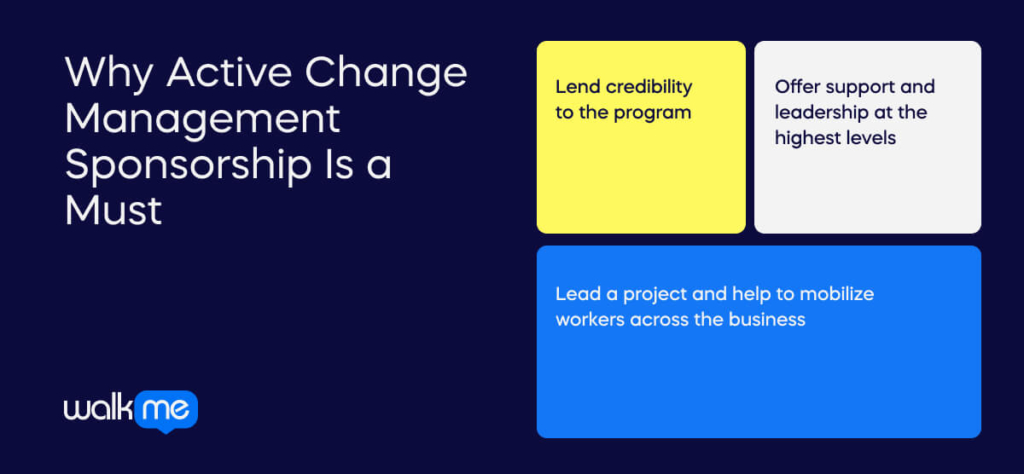For organizational change initiatives to succeed, change management sponsorship is usually a necessity.
Sponsors provide the visible leadership needed to drive a program forward, create a vision for change, and lend credibility to the change project. By staying actively involved in the leadership and governance of the project, they can ensure that programs remain a priority and stay on track.
Below, we’ll look at the benefits of sponsorship, why sponsors must be visible and active, and how to earn support from executive leaders.
Why Active Change Management Sponsorship Is a Must

There are several key reasons why change managers and project leaders should obtain sponsorship before beginning any change project.
Sponsors:
- Lend credibility to the program. Attaching an executive’s name to a project immediately adds more gravity to an initiative. Though the weight of that credibility may be difficult to quantify, it ultimately helps mobilize and influence employees at every level of the business.
- Offer support and leadership at the highest levels. Organizational changes often impact several business functions, and since executive leaders maintain close working relationships with one another, a sponsor can help earn the support of other senior leaders.
- Lead a project and help to mobilize workers across the business. An executive sponsor, as we will discover below, can play an active role in the execution and management of a project. That leadership, in turn, can have a large influence on the performance and the final results of the initiative.
For all of these reasons, change management experts always emphasize the need for active change leadership and sponsorship.
At the same time, it is equally important to recognize that a lack of sponsorship can have the opposite effects – less leadership, less credibility, less financial support, and so forth.
Sponsors must be more than just sponsors in name only, however.
According to Prosci, for instance, projects with effective sponsorship were three times more likely to meet their objectives.
To be successful, they must:
- Be committed to the change program. Real support comes from a commitment to change. Executive sponsors must have a reason to commit, of course, which is why it is important to establish a relationship with the sponsor and build a strong business case for the project.
- Be visible, proactive leaders. To succeed, a project requires an involved leader, financial resources, human capital, and more. Executive sponsors must step in to fulfill that role.
- Participate in the governance of the initiative. Change managers act as both project managers and people managers. But sponsors also have responsibilities when it comes to the governance of the higher levels of the project – building a coalition of stakeholders, for instance, is often something only an executive can accomplish.
Naturally, simply asking an executive for support is rarely enough to obtain sponsorship. To earn an executive’s full commitment, it is necessary to make a business case for the change project. Next, we’ll look at a few ways to do that.
3 Keys to Obtaining Executive-Level Sponsorship

Obtaining sponsorship in change management, as in any other business initiative, requires soft skills, an understanding of business, and insight into what executives need.
Here are a few tips to keep in mind when approaching potential sponsors:
Learn to speak the sponsor’s language
A business leader’s language reflects their interests and their business function.
As with any other business professional, executive sponsors each have their own business investments to watch for.
Also, every leader has their own angle and focus. For instance, a CIO may be interested in IT performance and agility, while others are more focused on ROI, others on risk, others on employee productivity, others on innovation, and so forth.
Discover where a sponsor’s interests lie and what they are most concerned about, then build a proposal with that language in mind.
Demonstrate a commitment to change
An executive sponsor is unlikely to support a change proposal if those proposing the project lack commitment themselves.
To demonstrate a commitment, it is important to:
- Take a structured approach to change management and prove that to the sponsor
- Outline a clear strategy and roadmap for change
- Explain the desired outcomes and how it will impact the business
- Perform tasks up front if possible, such as a cost-benefit analysis or a preliminary gap analysis
In short, if those proposing the change do not demonstrate a clear and total commitment to a project, sponsors won’t commit.
Show how the business and the sponsor will benefit from the change
As mentioned above, the change proposal should be couched in the language of the sponsor.
When outlining the benefits of the change project, therefore, it is important to understand what benefits to focus on and how to dimensionalize them for the proper audience.
Here are a few types of benefits that will be of interest to business leaders:
- Financial returns, such as cost savings and higher profits
- Employee productivity, employee skills, turnover rates, and job satisfaction
- Organizational performance and efficiency
- Innovation and agility
Preparing a business case can make a big difference in both whether an executive supports the project and how actively they involve themselves. It is crucial, therefore, to put time and effort into this early discussion.

